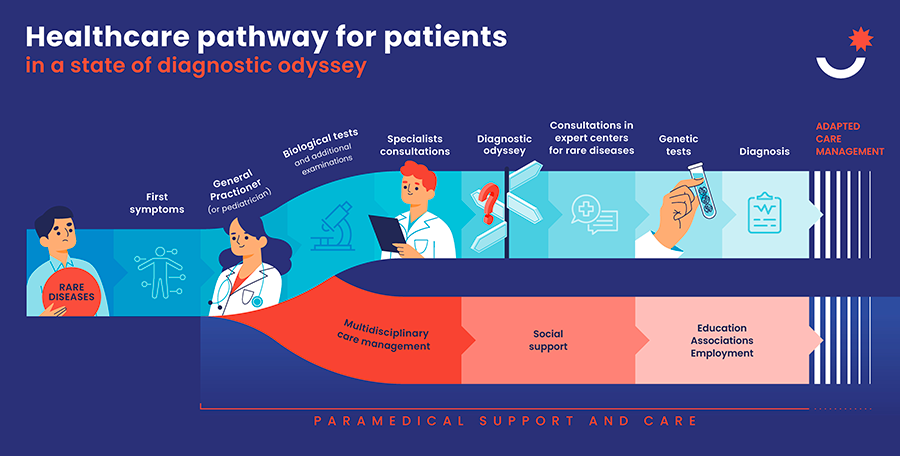Rare diseases currently affect between 3.5% and 5.9% of the world’s population, which equates to 300 million patients worldwide1. To date, they number more than 9,0002, of which 80% are considered genetic3. These conditions are complex and multifaceted, and the same type of mutation can cause different symptoms in different patients. In each case, the treatment pathway is unique and often laborious.
Diagnostic odyssey: A major challenge in rare genetic diseases
Symptoms of rare diseases are often manifold, vary from one individual to another, and tend to be non-specific. Such clinical complexity makes diagnosis particularly difficult for medical professionals and leads to a long and drawn-out ordeal for patients. At present, only one in two people with a rare disease has an accurate diagnosis4. For around a quarter of patients, time to diagnosis can be as long as four years5.

Reducing diagnostic uncertainty through genetic analysis
Rare diseases account for more than 30% of all infant deaths6, an alarming figure that highlights the need for earlier and more accurate diagnose. Several recent innovations, such as exome and whole genome sequencing, could significantly reduce diagnostic uncertainty. Identifying the diagnosis at an early stage of the disease would then allow for the most appropriate therapeutic management. However, their use raises a number of issues that stand in the way of widespread implementation, such as analyzing and managing a large volume of sensitive genetic data, obtaining informed consent from young children, and the potential risk of genetic discrimination.
From initial symptoms to diagnosis: A long and complex process
The patient journey for a rare disease generally begins with the onset of the first clinical symptoms, which are often non-specific and make it difficult to arrive at the right diagnosis from the outset. The doctors — general practitioners or specialists — initially explore the most frequent diagnostic and therapeutic hypotheses.
Due to the atypical nature of the clinical evolution, the worsening of symptoms and/or the lack of effectiveness of the initial treatment, patients are then referred to specialized centers for the treatment of rare diseases. These centers bring together multidisciplinary medical and paramedical teams highly specialized in one or more rare diseases, and operate as networks (e.g. European Reference Networks). They have the infrastructure and expertise to speed up the diagnosis of a particular rare disease by carrying out genetic tests when this type of medical condition is suspected.
Having a diagnosis allows the patient to have the most appropriate treatment – whenever and wherever possible – for their condition.

Genetic history: Diagnosing the disease before symptom onset
Rare neurodegenerative diseases begin with neuronal degeneration that does not initially cause any symptoms noticeable to the patient. When clinical symptoms become apparent, it generally means that the disease has progressed significantly. For people with a family history of the disease, it is sometimes possible to carry out screening tests early on, before the first symptoms manifest.
Multidisciplinarity: The key to a personalized care pathway
The care pathway begins when the first symptoms are detected but must be adapted once the diagnosis has been made. Disorders can vary greatly and affect different organs and systems. In 50% of cases, rare diseases lead to motor, sensory or intellectual impairment and in 9% of cases, complete loss of independence7. Patient care must take a comprehensive approach and generally entails:
“Patients with rare genetic diseases must be treated as part of a multidisciplinary care pathway involving several specialists and other health professionals. The vast majority of these medical conditions have as yet no treatment available. The aim is to support the patient and their carers — who often play a central role in their medical journey — in managing the symptoms and impact of the disease.”
Florence Keime-Guibert, Clinical Affairs and Partnerships Director, Neurology at Servier

Orphanet: Helping patients with rare diseases
Orphanet is a Europe-wide platform created by the French National Institute of Health and Medical Research (INSERM) to offer support to patients with rare diseases at every stage of their care pathway. They can find many valuable resources, including several directories — rare disease specialist centers, medical labs that provide diagnostic tests, patient associations and services — and much more.
Rare genetic diseases: Promising therapeutic developments
Curative treatments are currently available for less than 5% of rare diseases8. This has led research and pharmaceutical industry stakeholders to focus their efforts in recent years on:
Innovative therapies have emerged, such as gene therapy9 and RNA therapy10. Gene therapy makes it possible to correct the genetic modification present in the DNA that causes the disease. RNA therapies, in turn, are based on modifying the temporary copies of DNA – RNAs – using an array of techniques. Antisense oligonucleotides, for example, are nucleic acid sequences designed to bind specifically to messenger RNA (mRNA) molecules. By attaching themselves directly to these molecules, they can block or modify the transformation of the mRNA into defective proteins that can cause disease.
Research into these therapeutic strategies has given patients with rare genetic diseases hope that more effective and personalized treatments are on the way.
Have a look at the interview with Nicolas Lévy, Chief Scientist Rare Diseases at Servier
Committed to helping patients with rare diseases for over 30 years, he is the author of the book Les maladies rares et les espoirs de la médecine du futur (Rare Diseases and Future Medical Hopes).
[1] https://www.rarediseaseday.org/what-is-a-rare-disease/ – consulted on 18.02.2025
[2] https://www.embl.org/news/science/model-organism-data-rare-diseases/ – consulted on 18.02.2025
[3] https://sante.gouv.fr/soins-et-maladies/prises-en-charge-specialisees/maladies-rares/article/les-maladies-rares – consulted on 18.02.2025
[4] https://sante.gouv.fr/soins-et-maladies/prises-en-charge-specialisees/maladies-rares/article/journee-internationale-des-maladies-rares-432146#:~:text=Ainsi%2C%20une%20journ%C3%A9e%20internationale%20est,lieu%20le%2029%20f%C3%A9vrier%202024 – consulted on 18.02.2025
[5] https://www.alliance-maladies-rares.org/wp-content/uploads/2020/05/Erradiag-l-errance-diagnostic-dans-les-maladies-rares1.pdf – consulted on 18.02.2025
[6] https://www.inshs.cnrs.fr/fr/innovations-sociales-et-therapeutiques-pour-lamelioration-de-la-qualite-de-vie-des-jeunes-patients – consulted on 11.02.25
[7] https://sante.gouv.fr/soins-et-maladies/prises-en-charge-specialisees/maladies-rares/article/les-maladies-rares – consulted on 10.02.25
[8] https://alliance-maladies-rares.org/nos-combats/ – consulted on10.02.25
[9] Clinical applications of gene therapy for rare diseases: A review – Papaioannou – 2023 – International Journal of Experimental Pathology – Wiley Online Library – consulted on 20.02.25
[10] mRNA therapies: Pioneering a new era in rare genetic disease treatment – PubMed – consulted on 20.02.25
